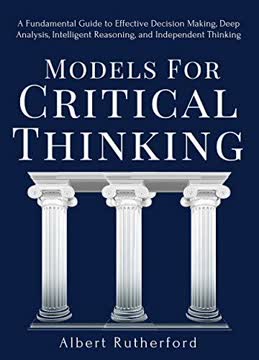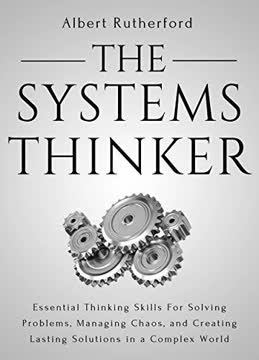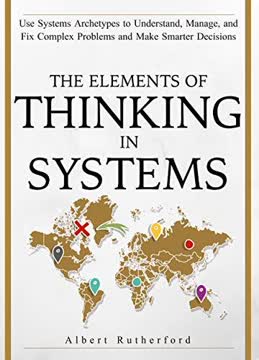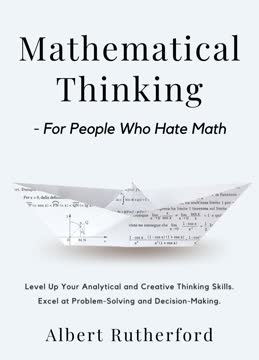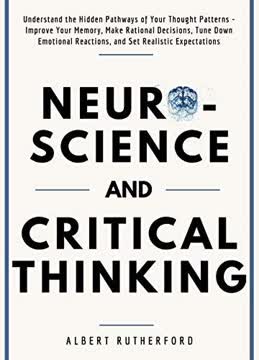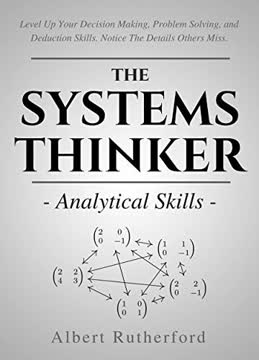Key Takeaways
1. Critical Thinking: Beyond Surface Understanding
According to the dictionary, critical thinking is the process of actively and skillfully conceptualizing, applying, analyzing, synthesizing, and evaluating information to reach an answer or conclusion.
Digging deeper. Critical thinking is not just accepting information at face value; it's a quest to understand the underlying reasons, question assumptions, and seek evidence. It involves asking good questions, examining context, and being open-minded to alternative explanations beyond the first one encountered. Logic and facts are valued over gut feelings or intuition.
Qualities and benefits. Critical thinkers are curious, lifelong learners who are aware of when critical thinking is needed and confident in their reasoning. They are receptive to differing viewpoints, objective in analysis, and recognize their own biases. This leads to better decision-making, increased tolerance, and the ability to challenge conventional views when evidence warrants it.
Conscious effort required. Thinking critically demands more cognitive effort than passively accepting beliefs or relying on instinct. It's a skill that doesn't come naturally and must be consciously practiced and taught. Without it, we risk clinging to beliefs based on faulty information or emotions, making irrational choices based on chance rather than reason.
2. Recognize How Your Thoughts Are Influenced
Indoctrination teaches ideas from only one point of view and expects them to be accepted completely without being questioned or challenged.
Outside forces shape us. Our thoughts are heavily influenced by social forces, often without our conscious awareness. From consumer choices dictated by influencers and algorithms to opinions shaped by peers and authority figures, external factors play a significant role in what we think and believe. This contrasts sharply with critical thinking's goal of independent thought.
Propaganda's power. Propaganda, historically used for religious and political purposes, became a tool for mass manipulation, notably by the Nazis. Hitler and Goebbels mastered playing on emotions and fears, repeating simple slogans to bypass intellect and prevent debate. They targeted the easily persuaded masses, controlling information to indoctrinate millions.
Spotting persuasion techniques. We are constantly bombarded by messages designed to persuade us to buy, vote, or believe certain things. Marketers and politicians use techniques like:
- Bandwagon effect (going with the crowd)
- Appealing to aspiration (living up to high standards)
- Expert appeal ("Trust me, I'm an expert")
- Vague language (saying little while talking a lot)
- Flattery and emotional appeals
- Misleading use of scientific evidence
- Offering simple solutions to complex problems
Awareness of these tactics is crucial for critical thinkers to resist manipulation and reclaim their own thinking.
3. Unmask Your Cognitive Biases
Cognitive illusions can cause people to cling even more tightly to their current beliefs and make them less receptive to information that differs from those beliefs and less willing to listen to people with other viewpoints.
Hardwired thinking errors. Humans are prone to predictable thinking errors, or cognitive biases, which are often rooted in our brain's attempt to conserve energy or respond quickly. These biases can lead to illogical conclusions and poor judgments, even when presented with contradictory evidence. Recognizing these patterns is the first step to overcoming them.
Common biases include:
- Belief Bias: Accepting conclusions that align with existing beliefs, regardless of logical validity.
- Confirmation Bias: Seeking and interpreting information that confirms pre-existing beliefs, while ignoring contradictory evidence.
- Hindsight Bias: Believing, after an event, that one "knew it all along," oversimplifying complex outcomes.
- Egocentric Bias: Overestimating one's own abilities or importance, leading to biased judgments (e.g., Argument from Authority, Ad Hominem).
- Loss Aversion: Feeling the pain of a loss more strongly than the pleasure of an equivalent gain, influencing risk-taking.
Mitigating their impact. While biases cannot be completely eliminated, increasing awareness of them allows us to consciously work to keep them in check. Strategies like metacognition (thinking about our thinking), seeking diverse viewpoints, and using structured decision-making processes can help mitigate their negative effects and improve objectivity.
4. Master Your Fast vs. Slow Thinking
Dr. Kahneman refers to fast thinking as System 1, “the instant, unconscious, automatic, emotional, intuitive thinking” and slow thinking as System 2, “the slower, conscious, rational, reasoning, deliberate thinking.”
Two systems at work. Daniel Kahneman's work highlights two distinct modes of thought. System 1 is fast, intuitive, and emotional, excellent for quick decisions but prone to errors and biases. System 2 is slow, deliberate, and logical, requiring significant energy but necessary for complex problem-solving and critical judgment. Our brains favor System 1 to conserve energy.
System 1's pitfalls. Fast thinking is easily influenced by mood and readily accepts information that confirms existing beliefs ("What you see is all there is"). It can lead to jumping to conclusions, overconfidence based on limited information (Law of Small Numbers, Illusion of Understanding), and being overly optimistic or risk-averse based on emotional responses like loss aversion.
Engaging System 2. The key is recognizing situations where System 1 is likely to lead to mistakes and consciously engaging System 2. This involves pausing, gathering more information, questioning initial impressions, and applying logical reasoning. While energy-intensive, this deliberate process is essential for making informed, rational decisions and avoiding predictable errors in judgment.
5. Build Knowledge: From Data to Wisdom
What you know isn’t nearly as important as how you know it.
Hierarchy of understanding. Learning progresses through a hierarchy: from raw Data (facts) to organized Information, then to Knowledge (seeing connections), Understanding (appreciating 'why'), and finally Wisdom (evaluated understanding, creating new insights, often involving values). Concrete, lower-level thinking (data, information) is the necessary foundation for abstract, higher-level thinking (knowledge, understanding, wisdom).
Processing information critically. The transition from data to information is where biases can easily creep in. Simply collecting facts isn't enough; how we organize, interpret, and process them is crucial. Critical thinkers question their own methods and assumptions during this process, asking:
- What are the potential biases of the source or presenter?
- Is the information relevant and sufficient?
- Are conclusions based on evidence or group consensus?
Personalized learning journey. John Dewey emphasized that learning is not a vacuum process; it must connect to prior experience and present needs, moving from concrete to general. Effective learning methods must be varied and individualized to account for unique strengths and interests. True engagement and effort stem from individual interest, making the learning process more effective and meaningful.
6. Empower Your Logic Toolkit
In real life situations, many arguments are inductive thus, at the end of the day, illogical.
Logic in everyday life. Informal logic is the practical application of reasoning to evaluate real-life arguments expressed in ordinary language. Unlike formal logic which uses symbols and strict structures, informal logic helps us analyze the premises and conclusions of everyday disagreements, even when assumptions are hidden or arguments are structurally flawed.
Deductive vs. Inductive Reasoning.
- Deductive: Moves from general premises to a specific conclusion. If premises are true, the conclusion must be true. Provides certainty but doesn't generate new information.
- Inductive: Moves from specific observations to a general conclusion. Conclusions are probable, not certain, and new evidence can disprove them. Used in science but considered "illogical" by strict logicians due to inherent uncertainty.
Identifying fallacies and flaws. Critical thinkers use logic to spot fallacies (invalid arguments) and errors in reasoning. This involves examining the structure of arguments (like syllogisms or "if-then" statements), assessing whether conditions are necessary or sufficient, and uncovering hidden assumptions. While formal logic structures (like affirming the antecedent or denying the consequent) can help analyze validity, real-life arguments often require evaluating the truthfulness and completeness of premises, not just their structure.
7. Apply the Paul-Elder Thinking Framework
The main goal of the intellectual standards is to help the individual become infused in all thinking and become better at reasoning.
Elements of thought. The Paul-Elder framework provides a structured approach to improving thinking by identifying its core components. All reasoning involves:
- Purpose (the goal)
- Question (the problem to solve)
- Assumptions (underlying beliefs)
- Point of View (perspective)
- Information (data/evidence)
- Inferences (conclusions drawn)
- Concepts (ideas/theories)
- Implications/Consequences (what follows)
Analyzing these elements helps clarify and strengthen one's own thinking and understand others'.
Intellectual standards. To assess the quality of reasoning, universal intellectual standards must be applied to the elements of thought. These standards include:
- Accuracy, Precision, Relevance
- Depth, Breadth, Logic
- Significance, Fairness
Consistently asking questions related to these standards (e.g., "How could we verify that?", "Can you be more specific?", "How is that connected?") helps ensure thinking is sound and well-supported.
Cultivating intellectual traits. Regular, disciplined application of the intellectual standards leads to the development of crucial intellectual traits. These include Intellectual Humility, Courage, Empathy, Autonomy, Integrity, Perseverance, Confidence in Reason, and Fair-mindedness. These traits characterize a cultivated critical thinker who is open-minded, rigorous in analysis, and committed to truth and reason.
8. Become a Critical Reader and Writer
Critical writing is when an author refuses to accept the conclusions of others without evaluating their arguments and evidence.
Active reading is key. Critical reading goes beyond passive absorption; it's an active process of questioning, challenging, and evaluating the author's arguments and evidence. Critical readers are skeptical, checking sources, identifying author biases and motivations, and assessing the relevance and timeliness of information. They understand that being in print doesn't guarantee truth or accuracy.
Evaluating the text. Critical readers examine the author's methodology and framework, considering:
- Theoretical vs. Empirical reliance
- Nomothetic (generalizing) vs. Idiographic (specific examples) approaches
- Distinguishing Cause vs. Correlation
- Scrutinizing Statistical Answers vs. Ideological Hypotheses
They also consider their own motivation for reading a text and its place within the broader body of knowledge on a topic.
Writing with critical rigor. Critical writing requires supporting all claims with evidence, acknowledging limitations, and addressing opposing viewpoints directly with counter-evidence. It involves thorough preparation (research, note-taking), clear structure (guiding question, outline, flow), and precise language tailored to the audience. Using references, keywords, transitions, and intermediate conclusions helps build a strong, persuasive, and well-supported argument that clearly answers the guiding question.
9. Understand Reasoning by Analogy
Analogies compare things that at first glance seem to be quite different from each other, but upon further examination have a connection between them or share some common traits.
Analogies simplify complexity. Analogies are powerful tools that enhance understanding and creativity by drawing comparisons between seemingly dissimilar things to highlight underlying connections or shared traits. They can simplify complex subjects by relating them to more familiar concepts, aiding in categorization and the selection of relevant ideas.
The double-edged sword of words. While language, including analogies and metaphors, is essential for communication and thought, it can also be ambiguous and imprecise. Critical thinkers must be aware that words can have multiple meanings and that context is crucial for accurate interpretation. Vague language can lead to misunderstandings and require listeners to make unwarranted leaps in thinking.
Identifying false analogies. False analogies draw comparisons between things that are fundamentally different in relevant ways, leading to invalid conclusions. Advertisers and politicians often use false analogies to evoke emotions and persuade without providing evidence (e.g., comparing cars and guns solely on their potential for harm without considering intent or primary function). Critical thinkers must carefully examine the connections highlighted in an analogy to determine if the comparison is valid and the argument has merit, rather than accepting it at face value.
Last updated:
FAQ
1. What is "Elements of Critical Thinking" by Albert Rutherford about?
- Comprehensive Guide to Critical Thinking: The book is a practical guide to understanding, developing, and applying critical thinking skills in everyday life, decision-making, and problem-solving.
- Focus on Deep Analysis: It explores how to analyze, evaluate, and synthesize information to reach well-supported conclusions, emphasizing the importance of evidence over intuition or authority.
- Addresses Influences and Biases: The book delves into how our thoughts are influenced by emotions, social pressures, and cognitive biases, and offers strategies to recognize and overcome these influences.
- Educational and Practical Models: It introduces educational frameworks like Bloom’s Taxonomy, SOLO Taxonomy, and the Paul-Elder Framework to structure and improve critical thinking.
- Real-World Application: Through examples, logic exercises, and historical lessons, the book shows how critical thinking can be applied to reading, writing, argumentation, and resisting propaganda.
2. Why should I read "Elements of Critical Thinking" by Albert Rutherford?
- Develop Independent Thinking: The book helps readers become more open-minded, objective, and independent in their reasoning, which is essential in a world full of misinformation and persuasion.
- Practical Tools and Frameworks: It provides actionable models and strategies for improving decision-making, analyzing arguments, and avoiding common thinking errors.
- Awareness of Biases: Readers learn to recognize their own cognitive biases and those of others, making them less susceptible to manipulation and faulty reasoning.
- Applicable Across Life Domains: The skills taught are relevant for personal, academic, and professional contexts, enhancing problem-solving, communication, and leadership abilities.
- Lifelong Learning Emphasis: The book encourages a mindset of continuous learning and adaptability, crucial for navigating complex and changing environments.
3. What is critical thinking according to "Elements of Critical Thinking" by Albert Rutherford?
- Active, Skillful Processing: Critical thinking is defined as the active and skillful conceptualization, application, analysis, synthesis, and evaluation of information to reach a reasoned conclusion.
- Questioning and Evidence-Based: It involves digging deeper than surface-level understanding, questioning assumptions, and demanding evidence before accepting claims—even from authority figures.
- Open-Mindedness and Skepticism: Critical thinkers are open to new evidence, willing to change their beliefs, and maintain a healthy skepticism toward information, including their own thoughts.
- Awareness of Bias: Recognizing and checking personal and others’ biases is central to critical thinking, as is the willingness to challenge the status quo and conventional wisdom.
4. What are the main benefits and qualities of a critical thinker in Rutherford’s view?
- Open-Minded and Tolerant: Critical thinkers are receptive to diverse viewpoints and see differing opinions as opportunities for learning.
- Analytical and Evidence-Oriented: They seek strong arguments supported by evidence, rather than accepting things at face value or relying on gut feelings.
- Confident and Curious: They are confident in their reasoning skills, curious to find better answers, and willing to adapt or abandon beliefs when presented with new information.
- Objective and Fair: Critical thinkers strive for objectivity, recognize their own biases, and reserve judgment until all facts are examined.
- Lifelong Learners: They are committed to continuous learning and self-improvement, always seeking to deepen their understanding.
5. How does "Elements of Critical Thinking" by Albert Rutherford explain what critical thinking is NOT?
- Not Just Formal or Negative: Critical thinking isn’t merely formal logic or about poking holes in others’ arguments; it’s about making informed, quality decisions in real life.
- Beyond Study Skills: It goes beyond memorization or study strategies, requiring evaluation of relevance, bias, and the strength of evidence.
- Not Accepting at Face Value: Non-critical thinking involves accepting information as presented, while weakly critical thinking only questions some aspects; strong critical thinking examines every assumption and source.
- Susceptibility to Bias: The book highlights common cognitive errors—like belief bias, confirmation bias, and hindsight bias—that are not part of true critical thinking and must be actively countered.
6. What are the key cognitive biases and thinking errors discussed in "Elements of Critical Thinking" by Albert Rutherford?
- Belief Bias: Accepting conclusions that fit existing beliefs without logical analysis.
- Confirmation Bias: Favoring information that supports pre-existing views and ignoring contradictory evidence.
- Hindsight and Egocentric Bias: Overestimating one’s ability to predict outcomes or overvaluing one’s own abilities and judgments.
- Stereotypes and Statistical Misunderstandings: Relying on stereotypes or misunderstanding statistics instead of objective analysis.
- Motivational and Cognitive Illusions: Letting emotions or unconscious biases distort reasoning, often leading to poor decisions.
7. How are our thoughts and decisions influenced, according to "Elements of Critical Thinking" by Albert Rutherford?
- Emotional Influence: Many thoughts are driven by emotions rather than rational analysis, making us vulnerable to manipulation.
- Social Pressures and Indoctrination: The desire to fit in, follow authority, or emulate influencers can override independent judgment.
- Propaganda and Persuasion: The book details how propaganda, advertising, and persuasive language exploit cognitive biases to shape beliefs and behaviors.
- Historical Lessons: Examples from Nazi Germany and modern marketing illustrate how repetition, emotional appeals, and selective information can indoctrinate or mislead masses.
8. What educational models for critical thinking are presented in "Elements of Critical Thinking" by Albert Rutherford?
- Bloom’s Taxonomy: A hierarchical model with six levels (Knowledge, Comprehension, Application, Analysis, Synthesis, Evaluation) for developing higher-order thinking.
- SOLO Taxonomy: A five-level model (Pre-structural, Uni-structural, Multi-structural, Relational, Extended Abstract) focusing on the structure of learning outcomes.
- Paul-Elder Framework: Emphasizes eight elements of thought (purpose, question, assumptions, point of view, information, inferences, concepts, implications) and intellectual standards (clarity, accuracy, precision, relevance, depth, breadth, logic, significance, fairness).
- Occam’s Razor: Advocates for the simplest explanation with the fewest assumptions when evaluating competing hypotheses.
9. How does Daniel Kahneman’s "Thinking, Fast and Slow" influence Rutherford’s approach in "Elements of Critical Thinking"?
- System 1 and System 2 Thinking: The book adopts Kahneman’s distinction between fast, intuitive (System 1) and slow, deliberate (System 2) thinking.
- Energy and Error: Fast thinking is energy-efficient but prone to errors and biases; slow thinking is more accurate but requires conscious effort.
- Jumping to Conclusions: The tendency to make snap judgments based on limited information is highlighted as a major source of error.
- Trust but Verify: Intuition can be useful, but critical thinkers should always seek evidence to confirm or challenge their gut feelings.
10. What practical tools and logic strategies does "Elements of Critical Thinking" by Albert Rutherford provide?
- Informal vs. Formal Logic: The book distinguishes between everyday informal logic and formal symbolic logic, emphasizing the former for real-life argumentation.
- Identifying Hidden Assumptions: Readers are taught to uncover and challenge both their own and others’ hidden assumptions to strengthen arguments.
- Necessary and Sufficient Conditions: Understanding these concepts helps clarify what is required for an argument or claim to be valid.
- Recognizing Fallacies: The book provides examples and exercises to help readers spot invalid arguments and logical fallacies in daily life.
11. How does "Elements of Critical Thinking" by Albert Rutherford address critical reading and writing?
- Active, Skeptical Reading: Critical readers question and challenge what they read, looking for biases, outdated information, and unsupported claims.
- Evaluating Sources and Methods: The book advises checking the credibility of sources, the author’s motivation, and the methodology behind arguments.
- Effective Note-Taking and Summarizing: Strategies are provided for retaining and organizing key information from texts.
- Critical Writing Skills: Emphasizes supporting claims with evidence, addressing opposing arguments, and structuring writing for clarity and persuasion.
12. What are the key takeaways and best quotes from "Elements of Critical Thinking" by Albert Rutherford?
- Key Takeaways: Critical thinking is a conscious, effortful process that requires questioning, evidence, and self-awareness. It is essential for resisting manipulation, making informed decisions, and adapting to new information.
- Best Quotes and Their Meaning:
- “Thinking and knowing are not the same things.” — Highlights the difference between having thoughts and possessing justified knowledge.
- “Critical thinkers want to see the proofs that lead to the conclusion before they are willing to believe it.” — Emphasizes the importance of evidence over authority or intuition.
- “We are not thinking machines. We are feeling machines that think.” — Underlines the role of emotion in human reasoning and the need for conscious critical thinking.
- “Beliefs are not absolute, but rather works in progress that can, and should, evolve and change over time.” — Encourages openness to new evidence and adaptability.
- Lifelong Learning: The book’s overarching message is that critical thinking is a lifelong journey, requiring continual practice, humility, and a willingness to challenge oneself and others.
Review Summary
Elements of Critical Thinking receives mixed reviews, with an overall rating of 3.98/5. Some readers praise it as a valuable refresher on critical thinking, highlighting its relevance in today's information-saturated world. They appreciate its engaging style and good examples. However, others criticize the book for poor editing, citing numerous errors and confusing explanations. One reviewer found these mistakes so prevalent that they discredited the entire book. Despite the criticism, many readers find the book's message important and timely.
Download PDF
Download EPUB
.epub digital book format is ideal for reading ebooks on phones, tablets, and e-readers.
